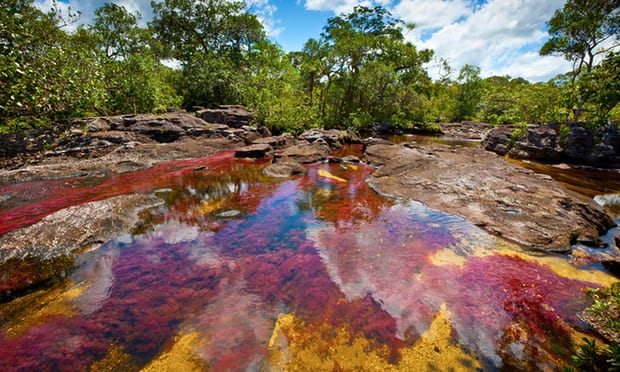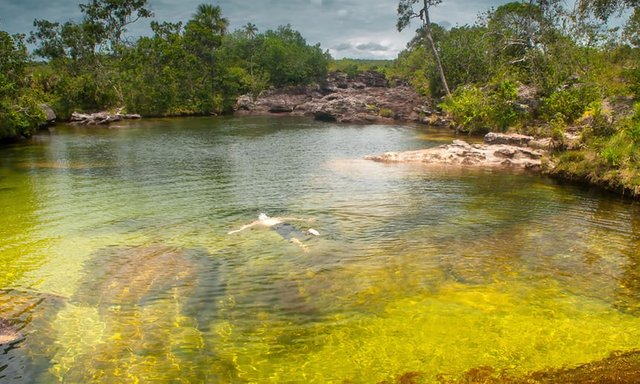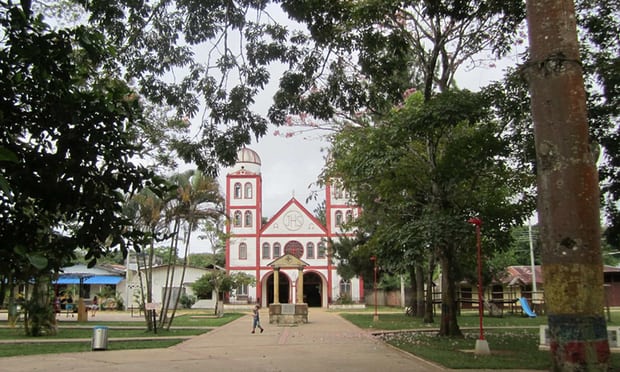Colombia’s rainbow river benefits from peace deal
One of Colombia’s natural wonders, the Caño Cristales river lies deep inside what was Farc rebel territory. But last month’s historic peace deal means tourists can enjoy its many-hued waters

Water colours … Caño Cristales, Colombia’s ‘river of five colours’ Photograph: Tom Till/Alamy
The first thing I felt when I saw the river running red was relief. The colour was more raspberry sorbet than blood red, flowing invitingly beneath soaring, skinny palm trees. Until this point, I had been slightly worried that Caño Cristales, Colombia’s so-called river of five colours, could be to water what the northern lights are to the night sky – unreliable and often nothing like the pictures.
But Caño Cristales had performed on cue. A mix of aquatic plants and tricks of the light combined to turn its waters a whole spectrum of colours. Circular rock pools, known as giant’s cauldrons, added to the spectacle, their shingled bottoms appearing to glow yellow and then green. It was easy to see why this little-known natural wonder is locally known as the liquid rainbow.
It hasn’t always gone smoothly, but progress here has been remarkable
Yet until recently Caño Cristales, in the wildest depths of the country’s interior, was less of a must-see – more a mustn’t see. It’s in the heart of what was Farc guerrilla territory, so instead of being in the guidebooks’ lists of top attractions, the river spent much of the early 2000s on the UK Foreign and Commonwealth Office (FCO) warning list to avoid for “all-but-essential travel”.
Things started to change when, 10 years ago, the state military launched a mission to take La Macarena, the river’s nearest town, back from Farc (the Revolutionary Armed Forces of Colombia). It hasn’t always gone smoothly, but progress has been remarkable. Gradually curious tourists have drifted in. In 2014, the FCO took Caño Cristales off the no-go list and instead advised going with a reputable tour operator.

Cano Cristales
Facebook Twitter Pinterest
Henry Quevedo, president of the Caño Cristales tourist board, believes tourism here is set to grow. At the end of last month, things took another big step forward when a revised peace treaty between the government of President Juan Manuel Santos – who has been awarded the 2016 Nobel peace prize – and Farc was approved by Congress. The first draft was rejected in a referendum – although La Macarena, one of the areas hardest hit by the conflict, voted 71% in its favour, a sure sign that it wants to move forward.
“The ecotourism project here began before work on the Colombian peace deal started and it relies on cooperation with the Colombian Army,” he told me, adding that this would not change; there would still be boots on the ground.
For a place that is still fairly new to tourism, La Macarena has blazed its way down the eco and community tourism route
I had travelled to La Macarena in 30-seater plane from Bogotá, 170 miles to the north. The town is a small grid of dirt roads, roughly six streets by eight, with, at its centre, a public park, where amenities include some tired playground apparatus and free Wi-Fi. Scents of tropical fruit wafted through the air from a juice stall. My hotel, the Punto Verde, had motel-style chalets surrounding a small pool in a well-kept garden of citrus trees, coconut palms and tropical flowers.
I had half-expected a semi-lawless land, where anyone can wander into the wilds like some sort of tourism pioneer, but there were rules here, lots of rules. Before I was allowed to go to the river, I had to attend a briefing along with all the other new arrivals. During a 10-minute presentation we were told sternly: no cigarettes, no feeding the fish, no treading on the aquatic plants, no plastic water bottles. And for those who wanted to swim in the river: no sun cream or insect repellant.

La Macarena.
Facebook Twitter Pinterest
La Macarena, the river’s nearest town
For a place that is still fairly new to tourism, La Macarena has blazed its way down the eco and community tourism route. “I think it started when someone found some photos of the river 30 years ago and it had double the amount of plants,” said my guide, Franchy.
Personally, I was happy to oblige. There were no mosquitoes, so the repellant was unnecessary. And for sun protection, I managed with long sleeves, long trousers and a hat – plus a dab of cream on my face. I vowed to keep my head above the water if I took a dip.
From September onwards is the best time to visit, as there are fewer tropical downpours
I had opted for a three-day trip, which meant I would have time to hit all the nearby highlights, including several waterfalls and swimming holes. Each day started in the same way: we would board a long, wooden boat and skim along the wide, tea-coloured Guayabero river: titi monkeys swung in the treetops, turtles basked at the water’s edge, and birds with neon-yellow breasts darted between the creepers.
Caño Cristales is a tributary flowing into the Guayabero a few miles downriver on the opposite bank, amid a plain filled with squat, purple-flowered vellozia bushes. When I finally stood at the stream’s edge, I could see carpets of the all-important macarenia clavigera plant, swaying gently under the surface. This is the plant that changes in sunlight from Kermit green to a dusky pink, creating optical wonders. Up close, the plants were pretty, but not astonishing. It was only from a short distance that the water appeared to be flowing like lava.

Cano cristales waterfall
Facebook Twitter Pinterest Photograph: Alamy
The tourism season in Caño Cristales is short, from July to December. From September onwards is the best time to visit, as there are fewer tropical downpours. Rain can mute the colours and, indeed, there are no guarantees that visitors will see all of the famous five – red, orange, yellow, green and blue. The blue continually eluded me.
Local guides are working on plans to attract visitors year-round by developing trips to other natural attractions in the area, but in the meantime, there is another problem. The oil companies are coming. Just metres from one of the river’s most beautiful spots, shiny black gold oozes from the ground.
“Some local people want the money it will bring. They want to see roads fixed, and more jobs,” said Maria Johanna, another local guide. “They say to me, ‘Oh, sure you just want to keep them out because you have a job in tourism’, but no – this river is a gift from God. We have to look it after it.”
Sign up to The Flyer: weekly travel inspiration, emailed direct to you
Read more
On my last night in La Macarena, the town put on a cultural show for the tourists: around 80 of us, mostly Colombians, aged from 20 to 70. We sat in rows in a community hall to watch performances by local musicians and school-age dancers. It was slightly awkward, as if La Macarena hasn’t quite figured out what to do with its influx of visitors, but it was clearly desperate to make a good impression.
As the entertainment drew to a close, the compère, a portly man in a large cowboy hat, looked emotional. “Tell your friends, tell your neighbours,” he called from the stage. “Here in La Macarena, you can live in peace. And you can visit the most beautiful river in the world.”
• The trip was provided by RealWorld (0113 262 5329), which has a seven-day package to Bogotá and Caños Cristales, including B&B accommodation and domestic flights, transfers and river tours, from £1,495pp. Flights for this trip were provided by Avianca (Avianca.com), which flies from Heathrow to Bogotá from £513 return, and the Colombian tourist board (Colombia.travel)
Hi! I am a robot. I just upvoted you! I found similar content that readers might be interested in:
https://www.theguardian.com/travel/2016/dec/10/colombia-cano-cristales-coloured-river-farc